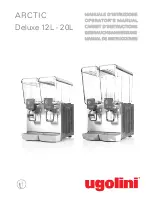
B - C r e a m & B - c r e a m H D
44
ENGLISH
12. 4 HOW TO CHARGE THE MACHINE WITH GAS
The “pressure gauge” shown in figure 5 is the type with 4 filling units (and 4 valves) because this type is most widely available on the
market, and it allows charging with gas both through the “High” and “Low Pressure” zones of the refrigerator circuit.
The refrigerator circuit on our machines is built so that the charging of gas may only be carried out through the compressor charging
tube ("Low Pressure" area): for this reason, the “HI” filling unit is not mentioned or used in our procedures and the “HI” valve should
therefore remain closed at all times.
1
Verify how many grams of gas should be decanted. This data, along with the type of gas, is indicated on the machine's
information plate.
2
Remove any containers and mixers from the machine.
3
Connect the machine’s plug to a power supply and switch the master switch to the "I" position.
4
Switch all the “Mixer and Refrigeration” switches to the “I” position and wait until all electrovalves are open (only in multiple
machines) and the compressor starts up.
5
Open the valve on the charging unit.
6
Open the “REF” valve on the pressure gauge slowly and gently, so that the refrigerant is pushed into the circuit in gas form.
7
When the quantity of gas indicated on the Information Plate has been decanted, the refrigerator circuit is charged. Close the
“REF” valve and the valve on the charging unit, keeping the compressor running for a further few minutes.
8
Make sure that all the evaporator cylinders are covered with frost.
9
Close the “LOW” valve, disconnect the “LOW” pipe from the compressor charging pipe and screw the cap onto the bottom of the
charging pipe.
As an indication, the temperatures and corresponding evaporation and condensation pressures at which the machines must operate
are indicated below.
These temperatures and pressures must be verified under the following operating conditions:
Ambient temperature: 32 °C
Temperature produced in the tank: 0 °C
In these conditions, the evaporation temperature should be approximately -10 °C and the condensation temperature approximately
50°C.
These temperatures should correspond with the temperatures indicated in the table below, depending on the refrigerant gas used:
13 COMPRESSOR FAULTS
To establish if a malfunction has occurred, proceed as follows:
1
Disconnect the machine’s plug from the power supply.
2
Disconnect the conductors from the compressor terminals.
3
Using an ohmmeter, measure the isolation between the terminals and the compressor housing. If the instrument indicates
continuity, the compressor has short-circuited.
4
In this situation, the compressor must be replaced using the following method:
5
Collect the gas as described in the paragraph "Discharging the gas".
6
Remove the faulty compressor.
7
Eliminate the cause of the compressor fault (check the conditions of the condenser both when the machine is started up and
when it is operating, and also the condition of the starter relay as possible sources and causes of the fault).
8
Install a new compressor and a new dehydrator filter.
9
Empty and charge the circuit as described above.
Refrigerant gas
Evaporation Pressure
Condensation Pressure
R134a
1,00 bar
12,00 bar
R404a
3,20 bar
22,00 bar









































